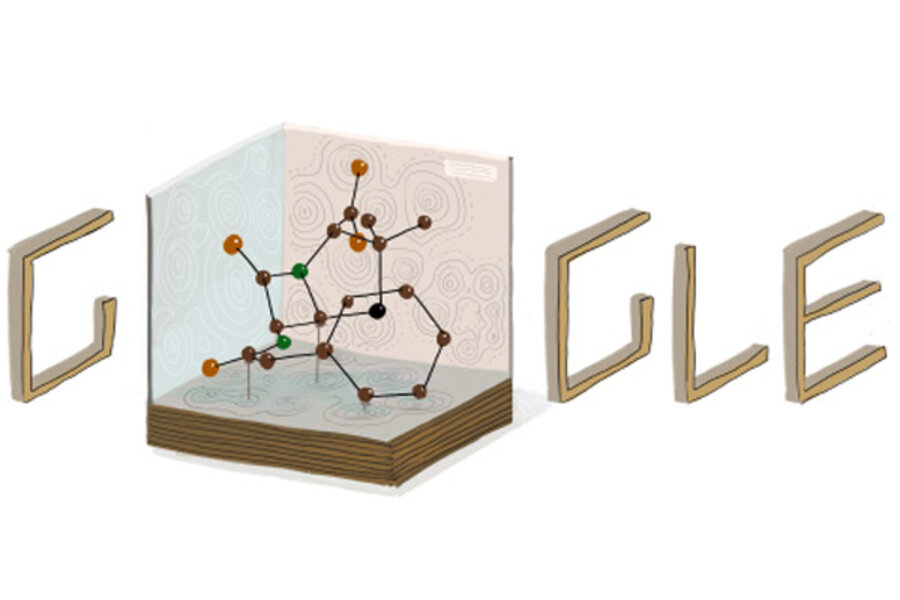Google honors Dorothy Hodgkin's X-ray vision
Loading...
In her acceptance speech for the 1964 Nobel Prize in Chemistry, Dorothy Hodgkin quoted a children's book by the eminent British scientist Sir William Henry Bragg:
"Broadly speaking," wrote Bragg in 1925, "the discovery of X-rays has increased the keenness of our vision over ten thousand times and we can now 'see' the individual atoms and molecules."
X-rays are most famous for their ability to pass through solid matter. That's what makes them popular in dentists' offices and airport security zones, for instance. Less well-known is their ability to help us determine the very structure of matter itself.
The science of X-ray crystallography began in April 1912, when the German physicist Max Laue and his colleagues placed a copper sulfate crystal between an X-ray tube and a photographic plate. As the X-rays passed through the crystal, bright spots on the photographic plate appeared, forming a distinct pattern. Just as waves in a lake striking a buoy produce secondary waves that ripple outward from the buoy, the X-rays, upon encountering the electrons in the crystal, had diffracted, leaving behind clues about the crystal's structure.
In this single experiment, Laue had uncovered two momentous facts about the natural world. First, that crystals formed a regular lattice structure; and second, that X-rays traveled like waves, and were thus a form of electromagnetic radiation, just like visible light. With uncharacteristic swiftness, the Royal Swedish Academy of Sciences awarded him the Nobel Prize in Physics less than 19 months later.
In the meantime, William Bragg, and his son, Lawrence, were busy working out the precise connection between the diffraction patterns and the atomic structure of crystals. After firing an X-ray beam at salt crystals and observing the patterns that the beam made on a photographic plate, Lawrence Bragg formulated what would come to be known as Bragg's law, which describes the mathematical relationship between the X-rays' wavelength, the distance between the planes in the crystals' lattice, and the angle at which the X-rays are reflected.
Their work earned the father-and-son team the 1915 Nobel Prize in physics and led to the creation of a new scientific field: X-ray crystallography. In the years that followed, another 26 Nobel Prizes have been awarded for discoveries related to X-ray crystallography, including the 1962 Nobel Prize in Physiology or Medicine for discovering the structure of the DNA molecule.
In the words of Max Perutz, who in 1962 was awarded the Nobel Prize for using this method to determine the structure of hemoglobin, X-ray crystallography has helped answer the questions of "[w]hy water boils at 100º and methane at -161º, why blood is red and grass is green, why diamond is hard and wax is soft, why glaciers flow and iron gets hard when you hammer it, how muscles contract, how sunlight makes plants grow and how living organisms have been able to evolve into ever more complex forms."
The discipline has even found its way to another planet. Inside NASA's Curiosity Mars rover is an X-ray tube and an image sensor, which, on October 17, 2012, carried out the first X-ray diffraction analysis of another planet's soil.
For her part, Dorothy Hodgkin used X-rays to determine the structures of penicillin, vitamin B12, and, five years after winning the Nobel Prize, insulin. Untangling these increasingly complex molecules was not a simple matter of plopping them between an X-ray tube and a photographic plate and applying Bragg's equation: Chemist Gunnar Hägg, who presented Hodgkin with her award, praised her perseverance, chemical knowledge, and gifted intuition, which has always been the mark of [her] work."
Hodgkin was one of four women to win the Nobel Prize for Chemistry, after Marie Curie in 1911 and her daughter, Irène Joliot-Curie, in 1935. The most recent recipient, in 2009, is the Israeli scientist Ada Yonath, who along with biologists Thomas Steitz and Venkatraman Ramakrishnan, discovered the structure of the ribosome, using X-ray crystallography.








